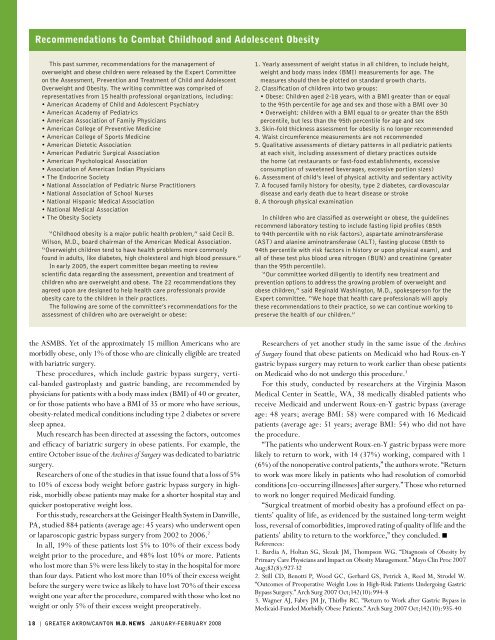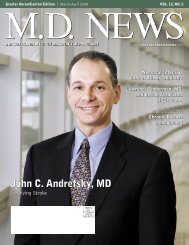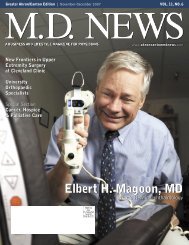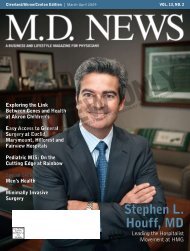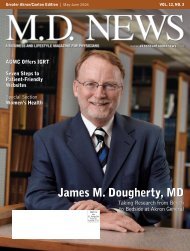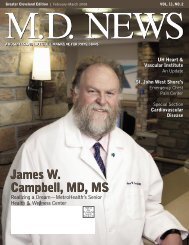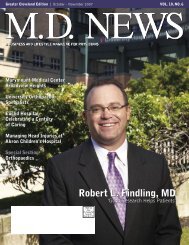Lisa Kohler, MD - AkronCantonMDNews
Lisa Kohler, MD - AkronCantonMDNews
Lisa Kohler, MD - AkronCantonMDNews
Create successful ePaper yourself
Turn your PDF publications into a flip-book with our unique Google optimized e-Paper software.
Recommendations to Combat Childhood and Adolescent Obesity<br />
This past summer, recommendations for the management of<br />
overweight and obese children were released by the Expert Committee<br />
on the Assessment, Prevention and Treatment of Child and Adolescent<br />
Overweight and Obesity. The writing committee was comprised of<br />
representatives from 15 health professional organizations, including:<br />
• American Academy of Child and Adolescent Psychiatry<br />
• American Academy of Pediatrics<br />
• American Association of Family Physicians<br />
• American College of Preventive Medicine<br />
• American College of Sports Medicine<br />
• American Dietetic Association<br />
• American Pediatric Surgical Association<br />
• American Psychological Association<br />
• Association of American Indian Physicians<br />
• The Endocrine Society<br />
• National Association of Pediatric Nurse Practitioners<br />
• National Association of School Nurses<br />
• National Hispanic Medical Association<br />
• National Medical Association<br />
• The Obesity Society<br />
“Childhood obesity is a major public health problem,” said Cecil B.<br />
Wilson, M.D., board chairman of the American Medical Association.<br />
“Overweight children tend to have health problems more commonly<br />
found in adults, like diabetes, high cholesterol and high blood pressure.”<br />
In early 2005, the expert committee began meeting to review<br />
scientific data regarding the assessment, prevention and treatment of<br />
children who are overweight and obese. The 22 recommendations they<br />
agreed upon are designed to help health care professionals provide<br />
obesity care to the children in their practices.<br />
The following are some of the committee’s recommendations for the<br />
assessment of children who are overweight or obese:<br />
1. Yearly assessment of weight status in all children, to include height,<br />
weight and body mass index (BMI) measurements for age. The<br />
measures should then be plotted on standard growth charts.<br />
2. Classification of children into two groups:<br />
• Obese: Children aged 2-18 years, with a BMI greater than or equal<br />
to the 95th percentile for age and sex and those with a BMI over 30<br />
• Overweight: children with a BMI equal to or greater than the 85th<br />
percentile, but less than the 95th percentile for age and sex<br />
3. Skin-fold thickness assessment for obesity is no longer recommended<br />
4. Waist circumference measurements are not recommended<br />
5. Qualitative assessments of dietary patterns in all pediatric patients<br />
at each visit, including assessment of dietary practices outside<br />
the home (at restaurants or fast-food establishments, excessive<br />
consumption of sweetened beverages, excessive portion sizes)<br />
6. Assessment of child’s level of physical activity and sedentary activity<br />
7. A focused family history for obesity, type 2 diabetes, cardiovascular<br />
disease and early death due to heart disease or stroke<br />
8. A thorough physical examination<br />
In children who are classified as overweight or obese, the guidelines<br />
recommend laboratory testing to include fasting lipid profiles (85th<br />
to 94th percentile with no risk factors), aspartate aminotransferase<br />
(AST) and alanine aminotransferase (ALT), fasting glucose (85th to<br />
94th percentile with risk factors in history or upon physical exam), and<br />
all of these test plus blood urea nitrogen (BUN) and creatinine (greater<br />
than the 95th percentile).<br />
“Our committee worked diligently to identify new treatment and<br />
prevention options to address the growing problem of overweight and<br />
obese children,” said Reginald Washington, M.D., spokesperson for the<br />
Expert committee. “We hope that health care professionals will apply<br />
these recommendations to their practice, so we can continue working to<br />
preserve the health of our children.”<br />
the ASMBS. Yet of the approximately 15 million Americans who are<br />
morbidly obese, only 1% of those who are clinically eligible are treated<br />
with bariatric surgery.<br />
These procedures, which include gastric bypass surgery, vertical-banded<br />
gastroplasty and gastric banding, are recommended by<br />
physicians for patients with a body mass index (BMI) of 40 or greater,<br />
or for those patients who have a BMI of 35 or more who have serious,<br />
obesity-related medical conditions including type 2 diabetes or severe<br />
sleep apnea.<br />
Much research has been directed at assessing the factors, outcomes<br />
and efficacy of bariatric surgery in obese patients. For example, the<br />
entire October issue of the Archives of Surgery was dedicated to bariatric<br />
surgery.<br />
Researchers of one of the studies in that issue found that a loss of 5%<br />
to 10% of excess body weight before gastric bypass surgery in highrisk,<br />
morbidly obese patients may make for a shorter hospital stay and<br />
quicker postoperative weight loss.<br />
For this study, researchers at the Geisinger Health System in Danville,<br />
PA, studied 884 patients (average age: 45 years) who underwent open<br />
or laparoscopic gastric bypass surgery from 2002 to 2006. 2<br />
In all, 19% of these patients lost 5% to 10% of their excess body<br />
weight prior to the procedure, and 48% lost 10% or more. Patients<br />
who lost more than 5% were less likely to stay in the hospital for more<br />
than four days. Patient who lost more than 10% of their excess weight<br />
before the surgery were twice as likely to have lost 70% of their excess<br />
weight one year after the procedure, compared with those who lost no<br />
weight or only 5% of their excess weight preoperatively.<br />
Researchers of yet another study in the same issue of the Archives<br />
of Surgery found that obese patients on Medicaid who had Roux-en-Y<br />
gastric bypass surgery may return to work earlier than obese patients<br />
on Medicaid who do not undergo this procedure. 3<br />
For this study, conducted by researchers at the Virginia Mason<br />
Medical Center in Seattle, WA, 38 medically disabled patients who<br />
receive Medicaid and underwent Roux-en-Y gastric bypass (average<br />
age: 48 years; average BMI: 58) were compared with 16 Medicaid<br />
patients (average age: 51 years; average BMI: 54) who did not have<br />
the procedure.<br />
“The patients who underwent Roux-en-Y gastric bypass were more<br />
likely to return to work, with 14 (37%) working, compared with 1<br />
(6%) of the nonoperative control patients,” the authors wrote. “Return<br />
to work was more likely in patients who had resolution of comorbid<br />
conditions [co-occurring illnesses] after surgery.” Those who returned<br />
to work no longer required Medicaid funding.<br />
“Surgical treatment of morbid obesity has a profound effect on patients’<br />
quality of life, as evidenced by the sustained long-term weight<br />
loss, reversal of comorbidities, improved rating of quality of life and the<br />
patients’ ability to return to the workforce,” they concluded. ■<br />
References:<br />
1. Bardia A, Holtan SG, Slezak JM, Thompson WG. “Diagnosis of Obesity by<br />
Primary Care Physicians and Impact on Obesity Management.” Mayo Clin Proc 2007<br />
Aug;82(8):927-32<br />
2. Still CD, Benotti P, Wood GC, Gerhard GS, Petrick A, Reed M, Strodel W.<br />
“Outcomes of Preoperative Weight Loss in High-Risk Patients Undergoing Gastric<br />
Bypass Surgery.” Arch Surg 2007 Oct;142(10):994-8<br />
3. Wagner AJ, Fabry JM Jr, Thirlby RC. “Return to Work after Gastric Bypass in<br />
Medicaid-Funded Morbidly Obese Patients.” Arch Surg 2007 Oct;142(10):935-40<br />
1 8 | GREATER AKRON/CANTON M.D. NEWS JANUARY-FEBRUARY 2008


